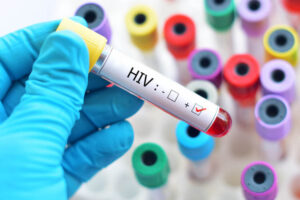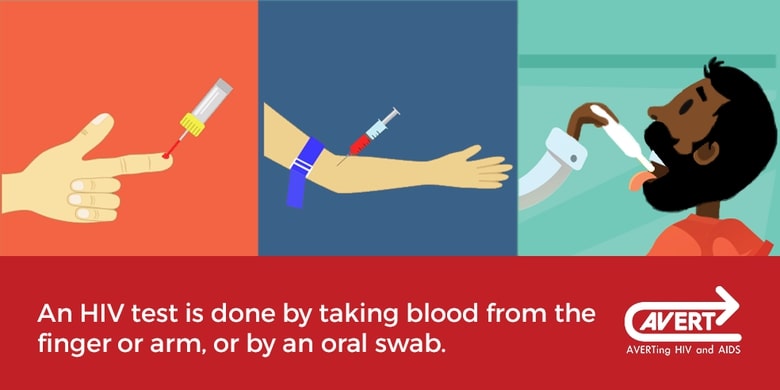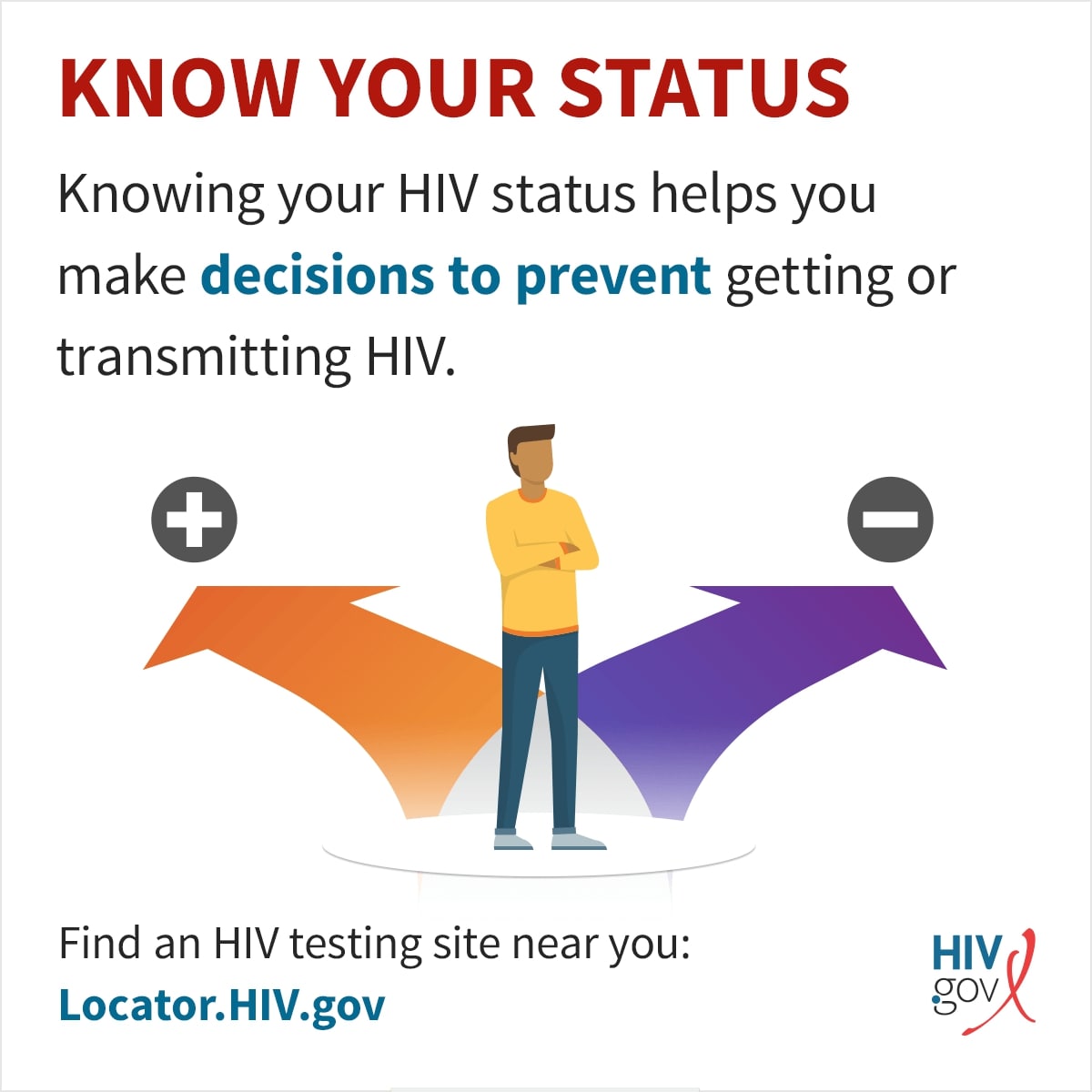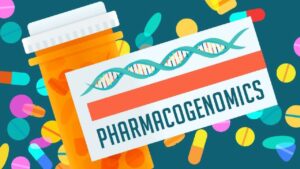Archive for June, 2022
National HIV Testing Day (NHTD) 2022. By Our Student Pharmacist, Andrew P. Capozzi.
Since its first observation in 1995, National HIV Testing Day (NHTD) has always taken place on June 27—and this year was no exception.
Sponsored by the United States Department of Health & Human Services (USDHHS), this day encourages the American public to get tested for HIV, or “human immunodeficiency virus,” to know their status, limit the spread of the virus, and potentially seek connections to health care services for support and treatment.
This year, NHTD has designated its 2022 theme as “HIV Testing is Self-Care,” suggesting that individuals taking action to get tested helps promote their physical and mental health, benefiting the community at large.
HIV is a virus that’s spread through sexual contact, the sharing of needles, or from a pregnant mother to her developing child.
Often, symptoms start two to four weeks after infection occurs, which can include:
- fever
- chills
- rash
- night sweats
- muscle aches
- sore throat
- swollen lymph nodes
- exhaustion
However, some individuals may have the HIV virus but not experience any symptoms. The only way to be certain if one is infected with the virus is to seek testing, which is available at pharmacies and healthcare sites throughout the local community. Additionally, many organizations offer self-testing kits that can be ordered online, completed at home, and mailed in for analysis.
Getting tested and knowing one’s HIV status can help make decisions to prevent getting or transmitting the virus. If untreated, the infection can lead to AIDS, or “acquired immunodeficiency syndrome,” which interferes with the body’s ability to fight infections and risks shortening one’s life.
To help prevent the spread of HIV, the Centers for Disease Control and Prevention (CDC) identifies the following recommendations:
- use protection when engaging in sexual activities
- take pre-exposure prophylaxis (PrEP) medication (if recommended and prescribed by a doctor) prior to sexual encounters
- practice abstinence from sex
- avoid sharing needles or syringes
- get tested regularly
HIV tests can be conducted in several different ways, with some tests having blood drawn from the arm, some having a small amount of blood taken from a finger-stick, and some having saliva collected from an oral swab. No matter what method of test you may choose or may be offered at a local site, you are helping the HIV epidemic get closer to its end and helping support the health of your local community.
While June 27 is primarily dedicated for national testing and awareness, we recommend that members of our communities consider taking a moment out of their week, just prior to the July 4th holiday weekend, to seek testing at their convenience.
Several sites around the Columbus area and beyond offer HIV testing services, as can be located on the USDHHS website at locator.hiv.gov.
In the near future, be on the lookout for upcoming HIV community testing clinics coordinated by Happy Druggist Pharmacy!
For more information, please visit www.cdc.gov/hiv
Resources:
Centers for Disease Control & Prevention (CDC). About HIV. U.S. Department of Health & Human Services. Published June 1, 2021. https://www.cdc.gov/hiv/basics/whatishiv.html
Centers for Disease Control & Prevention (CDC). National HIV Testing Day. U.S. Department of Health & Human Services. Published June 23, 2022. https://www.cdc.gov/hiv/library/awareness/testingday.html
Centers for Disease Control & Prevention (CDC). Prevention of HIV: The Basics. U.S. Department of Health & Human Services. Published June 1, 2021. https://www.cdc.gov/hiv/basics/prevention.html
U.S. Department of Health & Human Services. National HIV Testing Day. HIV.gov. Published June 22, 2022. https://www.hiv.gov/events/awareness-days/hiv-testing-day
Pharmacogenomics (PGx) & Community Pharmacies: Enabling Greater Access to Approaching Personalized Medicine. By Our Student Pharmacist, Andrew Capozzi.
Pharmacogenomics (PGx), also known as the study of how an individual’s genetic factors can affect the body’s response to a medication, is a growing field in the healthcare industry that helps in identifying medications that would be best for a patient’s treatment.
When pharmacogenomic testing is performed, healthcare providers are able to identify how the patient’s body may respond to a particular medication or class of medications, especially with a focus on effectiveness and risk of side effects. This information helps providers to acknowledge any variations that may exist within a person’s genetic code, to make recommendations when selecting treatments, and to design a “personalized medicine” approach to care. According to research at Washington State University, variations in genetic factors that affect the human body’s response to certain medications may be more widespread than initially believed, with most of the United States population likely carrying at least one actionable pharmacogenomic variant.
According to the Food and Drug Administration (FDA), about 500 medications include pharmacogenomic information in their labeling, primarily relating to how successful the medication may be for a patient, side effects that are of greater risk or severity, or any patient-specific dose adjustments that are recommended based on genetic profile.
Of all medications that are prescribed in the United States, it’s estimated that about 20% of them have a pharmacogenomic recommendation on their label. Most notably, medications that relate to cancer, mental health, heart health, blood thinning or clot prevention, and pain are most likely to be affected by genetic factors.
In particular, clopidogrel (Plavix), a blood thinner medication, is one of the most well-known examples of a medication that is impacted by a patient’s genetic profile. Clopidogrel is broken down in the body by an enzyme known as CYP2C19, which is produced from the coding of the CYP2C19 gene. Differences that may exist in the CYP2C19 gene’s composition may increase an individual’s risk for major side effects relating to heart health when clopidogrel is taken.
Pharmacists, often regarded as the most accessible and frequently visited of healthcare professionals, can play an important role in promoting the best treatment and medication plans for a patient. Equipped with specific knowledge, skills, and abilities to interpret and apply PGx results, pharmacists are integral in optimizing a patient’s treatment outcomes and potential long-term cost savings; additionally, providing education and counseling on the suggestions of PGx results.
Presently, pharmacists are already responsible for assessing the appropriateness of a medication and its dose with respect to a patient’s age, size, organ function, other diseases, diet, allergies, and other medications. With that in mind, PGx testing allows pharmacists to assess one additional source of response variability to individualizing drug therapy for a patient: genotype.
With community pharmacies serving as a link between patients, prescriptions, and sometimes even multiple healthcare providers, pharmacy personnel are able to advocate in a central and unique way for patient-specific interventions that are supported by their genetic information. Currently, training, education programs, laboratory infrastructure, and guidelines are being developed for pharmacy personnel to ensure a smooth adoption of PGx services and counseling in community settings. Today, genetic testing kits are available over-the-counter (OTC), typically costing about ~$175 per kit but varying from $99 to $1000. At this time, while insurance payer coverage for testing is not universally accepted in the United States for testing that is ordered by a healthcare provider, legal advancements to support the billing of such testing services are improving and promising.
As the field of pharmacogenomics continues to grow and as genetic tests become more readily accessible and less costly to perform, patients and providers both hope to reduce healthcare costs, pick the safest and most effective medications possible for a patient, and avoid having to use the traditional, but unpredictable “trial-and-error” approach to treatment. In the near future, PGx services may be coming to a Happy Druggist Pharmacy near you!
Resources:
Crutchley R. Personalized Medicine and the Future of Pharmacogenomics. Washington State University – College of Pharmacy Newsletter. Accessed June 23, 2022. https://pharmacy.wsu.edu/2022/02/11/personalized-medicine-and-the-future-of-pharmacogenomics/
Kennedy MJ. Personalized medicines – are pharmacists ready for the challenge? IPRP. 2018;7:113-123. doi:10.2147/IPRP.S133083
Kisor DF, Petry NJ, Bright DR. Pharmacogenomics in the United States Community Pharmacy Setting. PGPM. 2021;Volume 14:569-577. doi:10.2147/PGPM.S224894
National Community Pharmacists Association (NCPA). Pharmacogenomics. NCPA Resources. Published 2022. Accessed June 23, 2022. https://ncpa.org/pharmacogenomics
O’Connor SK, Michaels N, Ferreri S. Expansion of pharmacogenomics into the community pharmacy. Pharmacogenomics. 2015;16(3):175-180. doi:10.2217/pgs.14.183
Sunburn Treatment. By Our Student Pharmacist, Dennis Zhang.
- Pinkness or redness of skin
- Skin that feels warm or hot to touch
- Swelling
- Tenderness and pain
- Small fluid-filled blisters
- Fatigue, headache, or fever
- Mild sunburns are usually the ones with intact skin. They can be red, painful, and include swelling and blistering. Over-the-counter medicines can help with the symptoms and reduce discomfort. Skin protectants can prevent skin from rupturing. Mild sunburns are usually self-limiting and heal within seven days without scarring.
- More severe sunburns include blistering skin that ruptures. You might also experience fever, dizziness, nausea, or headache. If this happens, seek medical advice.
- Cool water
- As soon as you notice an area of skin that starts hurting in the sun, go indoors and place that area under running tap water (not ice water). Cool water during the first four hours of sunburn can lessen the pain. You can use cold compacts or tap water several times a day and enjoy the cold sensation, but it does not help with the burn anymore after four hours.
- Clean the sunburnt area
- Cleaning the skin can help prevent further infection. Use soapy water and drip on the burns. Do not rub the skin, because it is fragile and breaking the skin can cause further damage.
- Dressing
- Appropriate covering on the wound can protect the skin from scratching or unintentional frictions. Choose non-stick gauzes that contain petrolatum or saline.
- OTC burn products
- Protectants: Help maintain skin integrity and prevent dryness. However, they are usually ointments and can be messy and uncomfortable to use. They can be used as needed with or without coverings.
- Examples: Petrolatum 30-100%; Zinc Oxide 1-25%
- Pain relief: There are two classes of pain relief medications for sunburn. Oral pain medications such as ibuprofen (Advil) or naproxen (Aleve) are non-steroidal anti-inflammatory drugs (NSAIDs) that can reduce the pain and the swelling. Another option is topical pain medications. Those products work by blocking the nerve that sends the pain signal to the brain. Make sure that the skin is intact before applying the medication. Broken skin absorbs more drug into the body, which can cause irritation and significant side effects.
- Examples: Benzocaine 5-20%; lidocaine 0.5-4%.
- Topical corticosteroids: These work by reducing the inflammation, thus decreasing pain and tenderness. Avoid overuse of topical corticosteroids because overuse can lead to other skin conditions. Some experts are against the use of topical corticosteroids for sunburn because of a lack of evidence for their use.
- Example: Hydrocortisone 1% cream (with or without aloe vera)
- Antihistamines: These are generally used to relieve the itch when the skin is healing below the sunburnt layer. Taking diphenhydramine (Benadryl) at night helps with sleep and reduces scratches overnight.
- Aloe Vera: there isn’t enough evidence on aloe vera for sunburn. Aloe vera has some anti-inflammatory properties and can increase blood flow to the area, promoting healing. The sunburn products themselves are emollients that moisturize the damaged skin.
- Protectants: Help maintain skin integrity and prevent dryness. However, they are usually ointments and can be messy and uncomfortable to use. They can be used as needed with or without coverings.
International Pharmacy: Independent Pharmacy Practice in Germany. By Our Student Pharmacist, Andrew P. Capozzi.
 Pharmacy practice differs in many ways worldwide, especially when comparing that of European countries to that of the United States.
Pharmacy practice differs in many ways worldwide, especially when comparing that of European countries to that of the United States.
In the US, approximately 34% of all community pharmacies are independently owned, meaning that they are locally- and pharmacist-owned rather than a member of a corporate chain, such as Kroger, CVS, Walmart, or Walgreens.
In contrast, in Germany, federal law requires that all community pharmacies, known as “Apotheken,” are independently owned and operated. However, with this regulation, a pharmacist is restricted to owning a maximum of three pharmacy locations.
With German pharmacies, most medications that are dispensed are by prescription, although several “over-the-counter” (OTC) medications are also available, but require a pharmacist to discuss with the patient their effects and safe use. In the United States, many OTCs such as Tylenol (acetaminophen) or Motrin (ibuprofen) can be purchased without requiring a pharmacist to counsel the patient on their use. These medications can also be found in grocery stores and gas stations, unlike in Germany where these products are only able to be found in pharmacies.
A major contrast between Germany and the United States is the healthcare systems that govern the care of citizens. In the United States, healthcare is regulated privately, with the exceptions of Medicare and Medicaid, whereas insurance is required for German citizens, up to a certain income, and provided as a guaranteed right of care. This statutory health insurance (SHI) system covers about 88% of the German population, accounting for approximately 73.3 million people. This difference highlights unique pricing and medication access differences between the two countries.
In Germany, the government regulates medication pricing through their national formulary of approved medications, guaranteeing that every prescription drug will cost the same in every pharmacy. With this regulation, every insured person will have the same access to medications, regardless of their locale or financial status. Further, under the public insurance plan, prescription medications are virtually free of charge for patients, costing a maximum of 10 euros (~$10.50) per medication; although, this is countered by federal taxation of all citizens to accommodate the healthcare system and its associated fees. Surprisingly, however, insurers are not required to cover birth control pills for women older than 22, which can cost about $67 a month out-of-pocket. In the United States, the Affordable Care Act allows American insurance plans to cover contraception as a form of preventative medicine with no cost sharing.
While pharmacy hours certainly vary in the United States, German pharmacies are generally open Monday through Friday from 9 AM to 6:30 PM and on Saturdays from 9 AM to 1 PM. Interestingly, pharmacies within a certain region alternate in providing after-hours services, posting the schedule of which pharmacy is on duty for the night at the entrance of each pharmacy as well as in the newspaper.
Although there may be several perceived advantages to German healthcare and pharmacy practice, the systems are not without their flaws. For example, a major challenge in Germany is the lack of cooperation and integration between healthcare providers and various sectors, especially as electronic health record (EHR) systems, which assist with documenting a patient’s medical information and health plans in one place, had not been established until around January 2021.
Until the beginning of 2022, paper-based prescribing had remained the standard for providers, with the transition to electronic prescribing options going live only this January. Additionally, telehealth infrastructure had not been largely formalized until January, as well, finally granting distance-based care options for patients outside of a physician’s office.
Biggest takeaway points:
- German pharmacies must be owned by pharmacists.
- Typically OTCs, such as analgesics and cold and cough medications, are pharmacy-only products.
- By law, pharmacists must counsel on every medication, regardless if prescription or OTC.
- Medication prices are set by the government since public insurance plans are provided to citizens.
- Pharmacies in certain areas take turns offering 24-hour service to patients.
- Electronic health record systems, telehealth services, and electronic prescribing are relatively new to the German healthcare system.
Resources:
City of Bonn. Pharmacies (Apotheke). Bonn: Medical Care. Published 2022. Accessed June 16, 2022. https://www.bonn.de/microsite/en/services/medical-care/pharmacies.php
Eickhoff C, Griese-Mammen N, Mueller U, Said A, Schulz M. Primary healthcare policy and vision for community pharmacy and pharmacists in Germany. Pharm Pract (Granada). 2021;19(1):2248. doi:10.18549/PharmPract.2021.1.2248
Michos L, Holmes E. National Community Pharmacists Association (NCPA) Digest 2021. Published online October 2021. https://ncpa.org/sites/default/files/2021-10/2021-Digest.pdf
Strumann C, Möller B, Steinhäuser J. Einschätzungen zum elektronischen Rezept – eine Querschnittstudie unter Apothekern in Deutschland. Gesundheitswesen. Published online June 23, 2021:a-1498-1816. doi:10.1055/a-1498-1816
Lifestyle Changes for Hypertension. By Our Student Pharmacist, Dennis Zhang.
- Reduce the salt in your diet slowly. Aim for 2.3 grams of sodium every day first, then gradually decrease to 1.5 gram every day.
- Adding other flavors to your dishes. There are seasonings that are specific for restricting daily sodium intake. One brand I recommend is Mrs. DASH. It has a variety of salt-free flavors you can choose from.
- Read food labels. Some packaged food contains more sodium than you think.
- Switch from processed food to fresh vegetables and meats. Many pre-processed foods contain too much sodium to increase their taste.
- Lots of fruits, vegetables, and whole grains
- Some beans, peas, lentils, chickpeas, and similar foods
- Some nuts, such as walnuts, almonds, and peanuts
- Fat-free or low-fat milk and milk products
- Some fish
2. Mayo Clinic (2021, Feburary 24). 10 Drug-Free Ways to Control High Blood Pressure. Mayo Foundation for Medical Education and Research. mayoclinic.org/diseases-conditions/high-blood-pressure/in-depth/high-blood-pressure/art-20046974




















